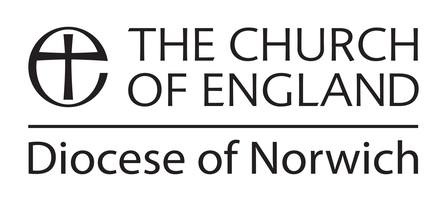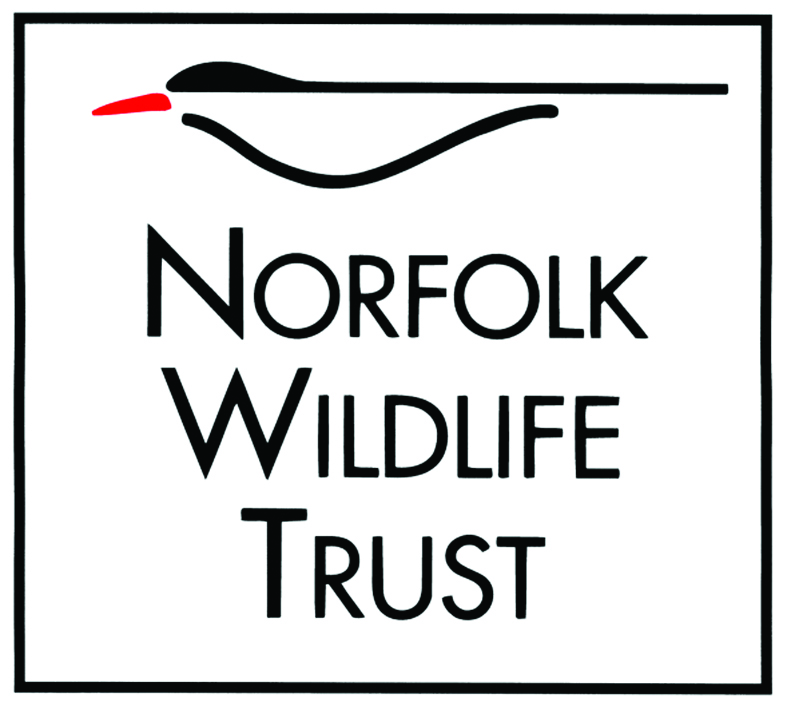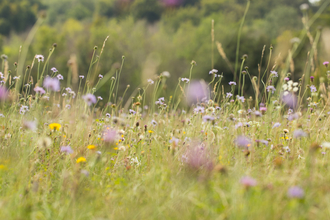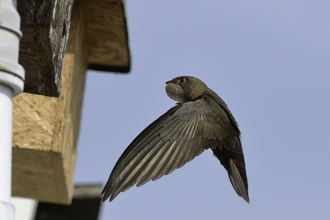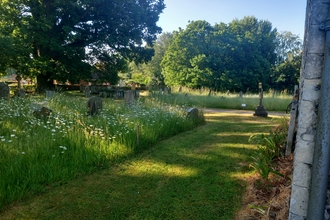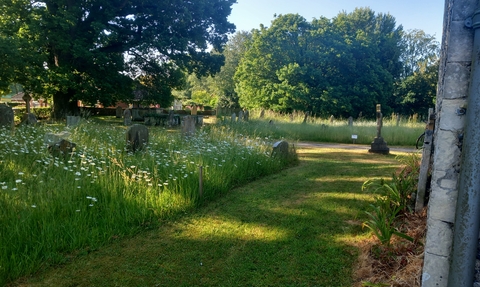
St Mary Church in Wroxham (credit: Lucy Seely)
Churchyard Conservation Scheme
How to manage a wildlife-friendly churchyard
From wildflowers to butterflies, swifts to slow worms, Norfolk’s churches are special places both for people and wildlife.
Norfolk is well known for its beautiful churches – and almost all 650 churches have a churchyard, which is often the only remaining undisturbed grassland in the parish and a haven for wildlife.
In collaboration with the Diocese of Norwich, we have run the Churchyard Conservation Scheme for over 40 years, offering advice to communities managing churchyards with wildlife in mind. In that time, our volunteers have visited over 500 of Norfolk’s churchyards to record their wildlife.
We aim to support communities to get to know the wildlife in their local churchyard, other churchland, or burial grounds, and work together to find ways to increase the value of these special places for wildlife.
As part of the scheme, we can:
-
Carry out a free plant survey
-
Discuss the individual needs of the church community
-
Offer management suggestions tailored to your churchyard or burial ground.
Managing a churchyard for wildlife does not mean leaving it to grow wild. We offer advice on how best to maintain your grassland for the existing wildlife and the community.
Interested in making your churchyard more wildlife-friendly?
If you are managing a churchyard and would like some advice, please get in touch or take a look at the information and resources below.
Resources
Free NWT Wildlife-friendly Churchyard Pack:
Churchyard wildlife ID card:
Churchyards for wildlife leaflet:
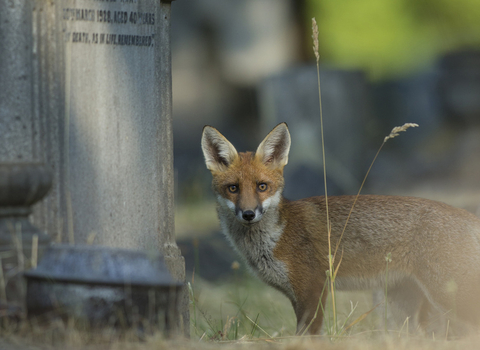
Churchyard fox (credit: Jamie Hall)
Contact us
Email the Churchyard teamSee below for downloads as part of our wildlife-friendly churchyard pack:
Grassland
Grassland management is often the key to managing your churchyard for wildlife. Getting the management right for grassland plants will directly benefit all sorts of wildlife in your churchyard – from pollinating insects and nesting birds, to sheltering amphibians to scarce grassland fungi.
Wildflower conservation areas: In general, wildflower-rich churchyard grassland should ideally be kept short mown for about nine months (from July to March) and left to grow longer for just three months (April, May and June).
Ideally, wildflower areas should be cut short in July, with the cuttings vigorously raked off and removed. The areas should then be returned to regular short mowing for the remainder of the growing season.
Cutting and raking are vital to wildflower diversity and creating a fine sward in churchyards.
Tended graves and memorial areas: Keep regularly, smartly mown.
Other grassy areas: These are the churchyard areas you want to keep short mown for access and for a neat appearance, and so they can be kept regularly mown. If possible, remove the clippings after each cut.
Download our Caring for grasslands booklet:
Hedges
Churchyard hedges can be great resources for many species of wildlife – providing food and shelter for birds, butterflies, small mammals, reptiles and amphibians.
A well-managed hedge can be very important for the wildlife in your churchyard. By trimming hedges in winter every two or three years, or by cutting half the hedge one year and the other half the next year, you will give birds, insects and small mammals as long as possible to feed and find shelter.
You could also avoid cutting the grass right up to the hedge until the autumn, instead leaving a rough grassy strip along the base of the hedge as shelter and habitat for wildlife during spring and summer.
Download our hedgerows guide:
Birds, bees and butterflies
Managing the churchyard wildflowers and hedges is one of the best and simplest ways to support birds, bees and butterflies. You may also like to install suitable bird, bat and insect boxes around your churchyard.
Download our guide to birds:
Download our guide to bees and butterflies:
Fungi
Churchyards contain a range of habitats that can be home to different species of fungi.
You can help them to thrive by keeping some areas of grass regularly short mown and avoid using fertilisers that can easily destroy sensitive grassland fungi. Mow vegetation under trees as tall growth will prevent fungi from ‘fruiting’ and leave piles of undisturbed deadwood branches where possible.
Download our guide to fungi:
Stonework plants and lichens
The old, undisturbed stonework of Norfolk churches and churchyards can be an important habitat for three scarce ferns, about 250 lichen species, mosses, and various other small plants.
The lichens and ferns do not pose a threat to the stonework. On church buildings, you can best support lichens by avoiding wholesale renovation work and leaving some areas with lichens so that they can gradually recolonise the stonework. To help lichens on headstones, try to prevent them from becoming shaded out by other species such as ivy, and avoid scrubbing or otherwise cleaning the stone.
Avoid using herbicide sprays on stonework anywhere near delicate ferns and lichens.
Learn how to care for lichens and other stonework plants:
Bats
Church buildings can be quiet, sheltered places for bats to live. Churchyards are often free from chemicals, making them rich in insect life. Well-managed wildflowers, longer grass, and hedges are beneficial for bats as sheltered insect hunting grounds.
Bat boxes can be used as additional shelter in churchyards.
Download our guide to bats:
Small mammals, amphibians and reptiles
You can provide protection, shelter, and food for small mammals, amphibians, and reptiles by managing your churchyard as a mosaic of chemical-free habitats, including short, medium and longer areas of grassland, deadwood, leaf piles and compost heaps, old trees and hedges.
Download our guide to caring for amphibians and reptiles:
Download our guide to caring for small mammals:
Communicate – tell your community what you’re doing and why
Let people know what is happening in your churchyard. A simple display in the porch to explain why you’re growing longer areas of grass and wildflowers, what plant species grow there, and how they are being managed with wildlife in mind can add interest for visitors.
Adding specific information about the timing of grass cutting can be an effective way of reassuring any concerns over changes in the churchyard’s appearance.
Upcoming churchyard events
Special thanks to
